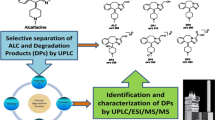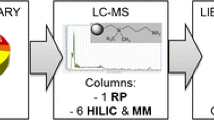Abstract
A comparison is made of the separation and analysis of a test probe, AZD5438 (4-(1-isopropyl-2-methyl-1H-imidazol-5-yl)-N-[4-(methylsulfonyl)phenyl]pyrimidin-2-amine), and its metabolites using conventional LC, UPLC and high temperature liquid chromatography (HTLC). LC and UPLC separations were performed using reversed-phase water:acetonitrile solvent systems whilst HTLC was performed with an entirely aqueous mobile phase, using both isothermal and temperature gradient chromatography. Substantial reductions in run times were observed with both UPLC and HTLC compared to the conventional LC approach without loss in chromatographic resolution for the major metabolites. At temperatures in excess of 100 °C, thermal degradation of some of the metabolites was observed in an isothermal separation, however, the application of a thermal gradient proved successful in maintaining the structural integrity of the analytes and simultaneously separating the parent compound and its major metabolites.






Similar content being viewed by others
References
Dell D (2004) Chromatographia 59:139–148s. doi:10.1365/s10337-003-0169-5
Jandera P (2002) J Chromatogr A 965:239–261. doi:10.1016/S0021-9673(01)01323-1
Johnson KA, Plumb R (2005) J Pharm Biomed Anal 39:805–810. doi:10.1016/j.jpba.2005.04.048
Wren SAC (2005) J Pharm Biomed Anal 38:337–343. doi:10.1016/j.jpba.2004.12.028
Zuiderwig FJ, Klinkenberg A (1956) Chem Eng Sci 5:271. doi:10.1016/0009-2509(56)80003-1
Edge AM, Shillingford S, Smith C, Payne R, Wilson ID (2006) J Chromatogr A 1132:206–210. doi:10.1016/j.chroma.2006.07.081
Apollonio LG, Pianca DJ, Whittall IR, Maher WA, Kyd JM (2006) J Chromatogr B Analyt Technol Biomed Life Sci 836:111–115. doi:10.1016/j.jchromb.2006.03.045
Wang X, Stoll DR, Carr PW, Schoenmakers PJ (2006) J Chromatogr A 1125:177–181. doi:10.1016/j.chroma.2006.05.048
Chruchwell MI, Twaddle NC, Meeker LR, Doerge DR (2005) J Chromatogr B Analyt Technol Biomed Life Sci 825:134–143. doi:10.1016/j.jchromb.2005.05.037
Li R, Dong L, Huang J (2005) Anal Chim Acta 546:167–173. doi:10.1016/j.aca.2005.04.073
Liu Y, Grinberg N, Thompson KC, Wenslow RM, Neue UD, Morrison D, Walter TH, O’Gara JE, Wyndham KD (2005) Anal Chim Acta 554:144–151. doi:10.1016/j.aca.2005.08.026
Plumb RS, Rainville P, Smith BW, Johnson KA, Castro-Perez J, Wilson ID, Nicholson JK (2006) Anal Chem 78:7278–7283. doi:10.1021/ac060935j
Edge AM, Shillingford S, Wilson ID (2007) Chromatographia 66:831–836. doi:10.1365/s10337-007-04331
Teutenberg T, Goetze HJ, Tuerk J, Ploeger J, Kiffmeyer TK, Schmidt KG, Kohorst W, Rohe T, Jansen HD, Weber H (2006) J Chromatogr A 1114:89–96. doi:10.1016/j.chroma.2006.02.041
Chen MH, Horvath C (1997) J Chromatogr A 788:51–61. doi:10.1016/S0021-9673(97)00715-2
Abbott S, Achener P, Simpson R, Klink F (1981) J Chromatogr A 218:123–135. doi:10.1016/S0021-9673(00)82051-8
http://www.waters.com/webassets/cms/library/docs/720002520en.pdf
Hartonen K, Riekkola M-L (2008) Trends Analyt Chem 27:1–14
Greibrokk T, Andersen T (2003) J Chromatogr A 1000:743–755. doi:10.1016/S0021-9673(02)01963-5
Smith CJ, Shillingford S, Edge AM, Bailey C, Wilson ID (2008) Chromatographia 67:673–678. doi:10.1365/s10337-008-0572-z
Gika HG, Theodoridis G, Extance J, Edge AM, Wilson ID (2008) J Chromatogr B Analyt Technol Biomed Life Sci 871:279–287. doi:10.1016/j.jchromb.2008.04.020
Acknowledgments
The authors gratefully acknowledge the support of Chris Smith from Shimadzu UK who supplied the LC and GC instrumentation and Waters for the supply of the Acquity UPLC system.
Author information
Authors and Affiliations
Corresponding author
Rights and permissions
About this article
Cite this article
Shillingford, S., Bishop, L., Smith, C.J. et al. Application of High Temperature LC to the Separation of AZD5438 (4-(1-Isopropyl-2-methyl-1H-imidazol-5-yl)-N-[4-(methylsulfonyl)phenyl]pyrimidin-2-amine) and Its Metabolites: Comparison of LC, UPLC and HTLC. Chroma 70, 37–44 (2009). https://doi.org/10.1365/s10337-009-1135-7
Received:
Revised:
Accepted:
Published:
Issue Date:
DOI: https://doi.org/10.1365/s10337-009-1135-7




